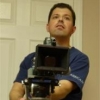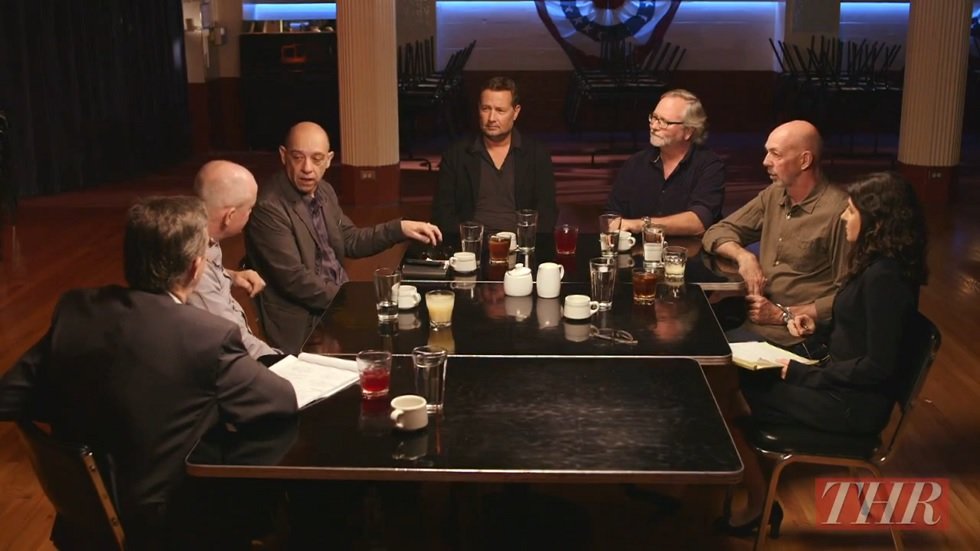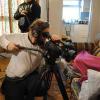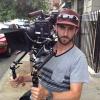Search the Community
Showing results for tags 'Digital'.
-
My question is partly technical, and partly just a curiosity: When shooting digitally, has anyone noticed a difference between shooting 23.976, and straight 24.00 FPS. I know this is the nearly negligible difference, but these are two different rates of capture. is there any perceptive change in how it feels or the way movement is perceived? Just some context: shooting a film with some folks that are used to shooting film. The project in mind will end up with some sort of theatrical release however it'll obviously be shot, finished and watched all digitally. If this isn't being printed to film, does NOT shooting 23.98 create an enormous post headache? Final question, is any of this worth exploring?
-
Saw this today and noticed a lot of clipping in the highlights. Anyone have similar experiences?...
-
As someone who loves film and the process of it all, and wanting a lucrative career in filmmaking, I would fight anyone who says shooting digital is better (than film) or anyone who puts film down for any reason because I believe film is superior. I still do, when it comes to the approach and the finished product. Well, fast forward into reality, I was about to throw down $3,000+ on an Arri BL4 (plus extras), spoke to a few owners who were more than willing to sell. And although I had that driving force to shoot film and have a big ol’ bad camera, something was bugging me, something was holding me back. Now, I am not a rich man, I’m just like you. But I started thinking, hmmm…most people can’t even tell the difference or don’t care about the difference in picture quality. They also aren’t helping me when I have to purchase, process and scan a 1000’ foot reel. Also, if I differ the costs to the client, then I price myself out of the market if I want to do any ‘for hire’ work. I’m also investing in a camera that will be hard to find parts. So what am I fighting for? Why do I want this uphill battle? Oh, right, the picture quality is supburb and digital still sucks. But it is getting better. Now as nostalgic as Super 8mm is, digital surpassed it. I don’t know if anyone out there could tell me they would want to see a feature length movie on Super 8mm. And as economically as it is to shoot 16mm to a certain extent, digital passed it in regards to resolution and clarity. And it’s just a matter of time before 35mm is caught up with, maybe this year by the new Alexa 65. With filmlabs dwindling in the world, and with Kodak one economic hiccup away from closing, why would I want any counterparty risk to be able to do my work? Yeah, yeah, Star Wars is supposed to be shot on film, etc. etc. etc. but if there’s an economic crash like is expected this year (possibly in the Sept. time frame), then Kodak will be gone, or will become super expensive. And if Kodak goes bye bye, then J.J. Abrams and team will be like, “Uhm guys, let’s do the George Lucas thing and shoot digital seeing that we can’t find any film. And Christopher Nolon might be crying in the bat cave.” And if there’s no film, then I doubt there will be any filmlabs. (Note: If you do not think we are set for a market crash or for an ever spiraling down of the U.S. economy, I invite you to take any U.S. currency bill out from your wallet (if you have any) and I guarantee you, you will not find a bill printed past 2009 (that includes that new $100 bill with the blue stripe…if you’re looking for some tangible proof to what I’m saying that is). You’re money is already monopoly money, you just may not know it yet, shh….mainstream news doesn’t want you to know. To this, l will say one thing and quote J.P. Morgan himself – “Gold is money, everything else is credit.”) So, do I want to buy a BL4 and possibly have nothing to feed it in the near future, and very limited places to process it when digital whom the masses have already accepted helps my wallet? Plain and simple, the infrastructure to shoot film is disappearing more and more everyday. Case in point, the two CVS stores that would develop my C-41 took their machines out last week. Now I have to travel or mail it somewhere. I don’t mind waiting for personal stuff, but for work and clients, I need it today. Now, I will still shoot film for personal use, my old Nikon FG is still kicking, or if I find a 16mm camera at a garage sale, or if a friend is shooting a 35mm movie and needs my help or my own little project, but for my work and my dime, uh-uh, I rather keep as much of my money as I can and shoot digital. What I do like about film is that it allows you be as artistic as you want to be, digital isn’t there yet, but it’s getting there on some level. And I’m not looking for a digital cam that will look just like film, that a pipe dream, but if I can find something I can at least work with, that could be something. I did see one video recently that got me thinking. It was footage shot with the Blackmagic production camera and here’s the link… Is the footage perfect? No, but it does have a different feel I think from the Alexas-Reds-Sonys-Genesis of the market. I could do something with this, I can work with it. The camera housing is butt-ugly, I would have to get passed that. And if not this camera, then another, but the bottom line is, digital makes a lot more cents. Where was my breakthrough you ask? I realized I was emotionally attached to film, and I needed to break that. It was clouding my mind from looking at things objectively. I didn’t want to do Blockbuster’s mistake and not foresee the trend and inadvertenly have my butt kicked to the curb by Netflix and Redbox. Big deal, I can’t call myself a ‘filmmaker’ because I’m not actually shooting physical film through a 40 lb. iron movie camera, oh well, I’ll just have to let that title go for a lucrative career. I’m sure I can find something else to call myself, like, ‘the camera guy,’ or ‘digitizer of the world’, whatever, who cares, at least I’ll have work and food in my stomach as I enjoy my craft. Just sharing my journey, maybe someone else can relate. Best regards, Alexander
-
I have a Alexa EV with 1841hr for sale. Asking $38000 firm. I have pictures I can email you. This is what is included in the package. 1 x Arri Alexa Camera w/ SxS Module - High Speed 4 x SxS 32GB Cards 1 x SxS Card Reader w/ AC Adapter and USB Cable 1 x Alexa Accessory Cable 12V (ARRI KC 154-SP-S) 1 x XLR 5-Pin Audio Out - L/R Channel 3-Pin Spliter 1 x 2ft Spiral Cord 3-Pin XLR Male to 3-Pin XLR Female 1 x Alexa Ethernet Cable 10ft (AEA-1) 1 x Alexa Viewfinder Interface Cable (Short) 1 x Alexa Viewfinder Interface Cable (Medium) 1 x Alexa Base Plate (BP-13) - 15mm (also have BP-12) 1 x Alexa Port Cap 1 x Arri Alexa Electronic Viewfinder (EVF-1) 1 x Alexa EVF Mounting Bracket 1 x Alexa Center Camera Handle (CCH-1) 1 x Alexa Handle Extension Block w/ Tape Hook (HEB-2) 1 x Alexa Battery Adapter Back for V Mount (BAB-V) 1 x Alexa Base Plate Adapter (BPA-1) 1 x Leveling Block (LB-1) 1 x Shoulder Pad (SP-3) 1 x Alexa EVF Extension Bracket 1 x 12in Dovetail
-
The director and I took the concept of B - Horror Films and many horror films from the 80's as an inspiration for the film, and then thought what if we did what Grind House films do (Double Feature), but with music videos instead. We shot on 5219 Pushed a stop for the grim reaper sequences and Canon C300, I wanted to embrace the idea of contrasting the formats within the story. The concept came first and then we asked a variety of bands and ended up with four. In order: White Lies Casket Girls PTA (People's Temple of America) Sleepy Cheese I would love to hear your critiques on the music video. Thanks and Enjoy! http://vimeo.com/110548281
-
Hi everyone I am sorry if I brought such a subject which has been discussed I guess so many times which is Film vs Digital, I don’t want to discuss the technical aspect I want more to see your opinion about the evolution of cinema and how tools can help doing this I watched recently the THR (The Hollywood reporter) roundtable (Cinematographers) you can watch in the link bellow. And they started as usual praising Film, which still looks better than Digital until NOWDAYS and I am sure Digital will surpass it in the next decade. And I can quote some what they said: Bruno Delbonnel “we are going from watchmaking if I may say so, an ArriFlex Camera or a Panavision Camera were like a Swiss Watchmaker, it was really precise, it cost a fortune .. $300k and now we gonna use camera which gonna be $2000, the problem is It’s an economical decision it’s not an Artistic decision, ….. “ With all my respect to them, First off, I don’t know if the guy has a clue about Digital cameras prices or he is comparing Film Camera to Panasonic DSLR’s !! And something that we really have to know, is it really just about money? Or Cinema/video tools have to evolve to give us better tools in the future that we can use to better tell stories ? If you watch the Roundtable, you find a lot of opinions regarding Old vs New tools which is for me a kind of “Orthodox” traditional way of thinking, that some of the Great Cinematographers still believe in, not just in this roundtable but in general, I would like quote some other things that have been said (About lenses sharpness, film grains, look, 3D,…) but I guess the post is long enough to mention this here. And I hope I can discuss this in details if people are interested To put it in a nutshell, Are we supposed to take care of Digital, evolve it in way it can be better than Film and even to Mimic Film for Film look lovers, or still praising film until the end of the days? Regards
- 108 replies
-
BURBANK, CA - FotoKem recently completed the digital intermediate and post production services for the indie film Palo Alto. Working with director/screenwriter Gia Coppola and cinematographer Autumn Durald, FotoKem colorist Alastor Arnold fine-tuned the natural look created in camera to ensure the filmmakers' vision for this teen tale is reflected on the big screen. Based on James Franco's short story collection about rebellious high school kids in suburban California, Palo Alto has been praised for Coppola's coming-of-age storytelling and for Durald's evocative photography. The film, which marks Coppola's feature debut, garnered raves at the Tribeca, Telluride, Toronto and Venice film festivals before its recent release. "Gia and I had worked together on five projects prior to this feature, so we have a similar visual language, taste and sensibilities," says Durald. "Gia is from a photography background, and we pulled a lot of photographic references for the tone and mood we wanted - photos by Stephen Shore and William Eggleston. It was important to have a more filmic, softer texture to the image that harkened back to movies like The Outsiders and Dazed and Confused - something that looked more aged with softer tones in the blacks as well. And nothing overly saturated and contrasty." Durald shot the feature with a Panavised RED Epic camera, mounted with Panavision Super Speed lenses and vintage 1970s glass to give a softer feel to the image. The on-set DIT handled basic data management and adjusted stills in REDCINE-X, but no LUTs were applied. Durald's RED raw R3D files were transcoded for final color using REDlogFilm for flexibility with various film/lab emulations. When Coppola and Durald met with Arnold, they brought their look-book of still photography and suggested some films for him to watch, including The Last Picture Show, American Graffiti and The Virgin Suicides. They also experimented with different combinations of film emulation LUTs and grain treatments on various scenes from the feature. "First and foremost, they wanted a very filmic approach to keeping the image natural, smooth, and most importantly beautiful," recalls Arnold. "We weren't pushing in a hyper digital direction. Autumn's photography was awesome, a unique look with a consistency of tonality - it was in a very warm place with naturalistic skin tones." Arnold demonstrated Fuji and Kodak film emulation LUTs along with variants involving slightly different color spaces and lab processes. "We were really happy with the Kodak LUT as the base, and then we added grain over that as well," says Durald. Using the Quantel Pablo for grading, Arnold suggested using its noise treatment feature in different blending modes and intensities to give a grain pass to the entire film. "It all ran in real time, so it was really interactive and fast to adjust noise to emulate different exposures," he reports. He gave particular attention to sodium vapor night exterior shots, tilting toward warm ambers instead of greens and making sure that black levels "felt appropriate for night but didn't bury anything - you always felt you could get into them." Arnold credits Durald's talents as a DP with making the DI process more about collaboration and experimentation than fixing things. "We never struggled to match a key to another key or to even things out," Arnold notes. "It was all about finding the right feel, tonalities, densities and grain. It was great to have the filmmakers walk in with a concise understanding of where they wanted to go stylistically with the finish." Durald concludes, "Alastor has a really great eye - he understood what we were going for from the outset. It's really important to find people with the same taste and sensibilities you have who can translate your visual language emotionally and technically."
-
- post production
- digital
-
(and 4 more)
Tagged with:
-
As part of our student film, we'd like to have a long steadicam shot which employs a varying dutch angle. If we add the tilting with After Effects, would the result be the same as if we had done it physically? Ed
- 3 replies
-
- dutch angle
- tilt
- (and 4 more)
-
As I understand it, most big-budget feature movies record on film as opposed to digital; the common claim being that film provides a much more cinematic image, etc. Does anyone think that we'll come to a point when digital cameras are able to produce an image, indistinguishable from film - and that cinematographers will choose digital over film due to artistic choices instead of being led by financial considerations?
-
Hey everybody After getting my Black Magic Pocket Cam, and a bunch of accessories, I'm about to start delving into the wonderful world, and perform some lens tests. I have 4 Schneider Prims, and 4 Kern Primes. The gear is almost complete. But I'm stuck in finding a solution for a ND Filter for these little primes. Any suggestions? I'm not sure if there's any that could fit a Matte Box? Not sure if that is still used. Thanks, F
- 3 replies
-
- 16mm
- black magic
- (and 5 more)
-
So, after surfing around the forums and googling, etc. I have sparked up some questions I have about cameras and such. I was reading the Catching Fire thread where Jo Willems and Dave Thompson have actually posted, which is downright awesome, but while reading some of their responses, I found myself getting a little lost. I'm 19 and have been shooting pictures (not much video) for about 5-6 years now and have picked up my fair share of knowledge on my own, and I've never had any "formal training", if we can put it that way. Anyways, I of course know all of the basics about equipment (or I believe I do) and composition and such, but I read articles of DP's being interviewed and then the Jo Willems forum post and I'm so confused sometimes. For example, a bunch of them keep talking about E, C and G lenses and I'm not sure what that translates to. Also I was wondering some stuff about anamorphic, and aspect ratios. I know about the common ones like 16:9 and such, but I've seen them post about 2.39:1, etc. I'm really trying to get this whole cinematographer thing to work after college, with moving to NY and what not, but I feel overwhelmed at times thinking about all the things I have yet to learn! Thanks in advance for any responses, everything is appreciated.
-
http://finearts.concordia.ca/officeofthedean/jobpostings/digital-cinema---film-production.php Roy Cross, MFA Associate Professor, Head, Film Production Programme Mel Hoppenheim School of Cinema Concordia University 1455 boul. de maisonneuve ouest Montréal, Québec, H3G 1M8 514.848.2424 ext 4659 cinema.concordia.ca roy.cross@concordia.ca www.roycross.com
-
Hi there, I am currently creating a research project for my final piece at university on the evolution of the cinema camera and how cinematographers deal with the ever changing technology. In particular the transition from 35mm celluloid to digital. I am looking for people who have worked with film stock and digital and wish to answer a set of questions I have prepared. The questions below have been sent out to various D.O.P's and also camera companies such as Arri, RED and Panasonic. During your time in the film industry, what do you believe to be the main changes in the technology used, especially in regards to the shift from celluloid to digital? What do you think the benefits are of digital cameras? Do you feel celluloid is dead? If so, do you feel moving away from celluloid is a good idea? If not, then why do you think this? What do you prefer yourself, celluloid or digital? Please explain your as detailed as possible. When you started out in the industry what camera were you using? How does this compare to what you are using now? Do you feel the digital age of cameras has opened the door to younger filmmakers due to the technology being cheaper? On top of asking D.O.P's themselves, I also want to open these questions up to various forums and find out what the community thinks in regards to celluloid vs digital. If any of you would like to answer the questions above (you dont need to answer all of them if you dont want to) then that would be brilliant and I would be very grateful. Also, if any of you have any other points that you wish to make in regards to the evolution of the cinema camera then please feel free to comment. Thank you for your time. Alun.
-
Hello There, I am an avid gear head and film student. For one of my classes I have choosen to write a research paper on the change from shooting mostly on film to mostly digital or as its called the "digital revolution". I am just curious how prevelent a change it has been on set and overall in the industry for actual professionals compared to what I have been reading. Also if anyone happens to have any good articles on the subject I would be much interested to check them out. thanks, Peter Lyngso
-
I'm in my final year of university creating a 10 minute short film. Our final scene includes a camping a scene with a father and a son, as we're filming at night time we're planning to only shoot with a single light source from a standard camping light, which will be placed just in front of the two actors. Will this be an effective way to shoot this scene? Is there anything else that we can do to make sure that the lighting of this scene looks good? We're filming just by a lake in the middle of a forest so exterior lighting from other sources will be very limited. Any suggestions??
- 7 replies
-
- Lighting
- Night time
-
(and 4 more)
Tagged with:
-
I'm a student at Karelia -university in Finland. I'm writing my thesis on "How to make digital video look like it was shot on film in the 70's". My thesis aims to answer questions like 'why did movies look the way they did in the 70's', 'why and how does deteriorated film look' and 'how can you achieve that look with modern tools'. I focus on the post-production part. If you could answer one or more of the following questions, I'd be most grateful. Or if you know a book or a website (other than Wikipedia) which deals with these subjects, that could help too. 1. How were the colors of the film altered or enhanced in the 70's? If I understand correctly it was done chemically somehow. Could you alter colors separately or would the alteration affect other colors as well? 2. How has film stock improved from the 70's to this day? 35mm film was used back then and it's used nowadays, so what is different? For example, older movies look softer or blurred compared to movies nowadays. Is this due to film stock getting better, or some other factor? 3. Color fading. I've come to understand that the colors of the film stock fade at a different rate. Cyan fades faster than yellow and yellow fades faster than magenta. Still, I have seen older horror movies that are quite heavily blue tinted. Of course I haven't seen them on film, but on DVD or Blu-ray made from the film. Are there some variables to how the colors fade? 4. Why do older movies have more film grain than newer movies? They are caused by silver particles in the film stock, if I'm correct. Is this due to film stock or camera equipment getting better?
-
Im a cinematographer based in Stockholm, Sweden. This is my showreel from 2012, looking to improve it and add newly shot projects aswell. Would love to have some input about pacing, shot selection and overall impression upon viewing. Thanks
- 3 replies
-
- showreeldemoreel
- Stockholm
-
(and 3 more)
Tagged with:
-
Has anyone had trouble using either the Sonnett PCIe Thunderbolt Expansion Chasis or the Magma Thunderbolt Expansion Chasis with a Red Rocket installed?? I am running 10.7.4 Lion, so the OS is not the issue. I get incredibly unpredictable behavior, such as drives ejecting out of nowhere, drives going bad randomly, transcodes failing, and other strange things. I think it may have to do with the newness of Thunderbolt, mixed with high bandwidth processing. Advice? Ideas? Cheers, Joe
-
- red rocket
- red
- (and 7 more)











